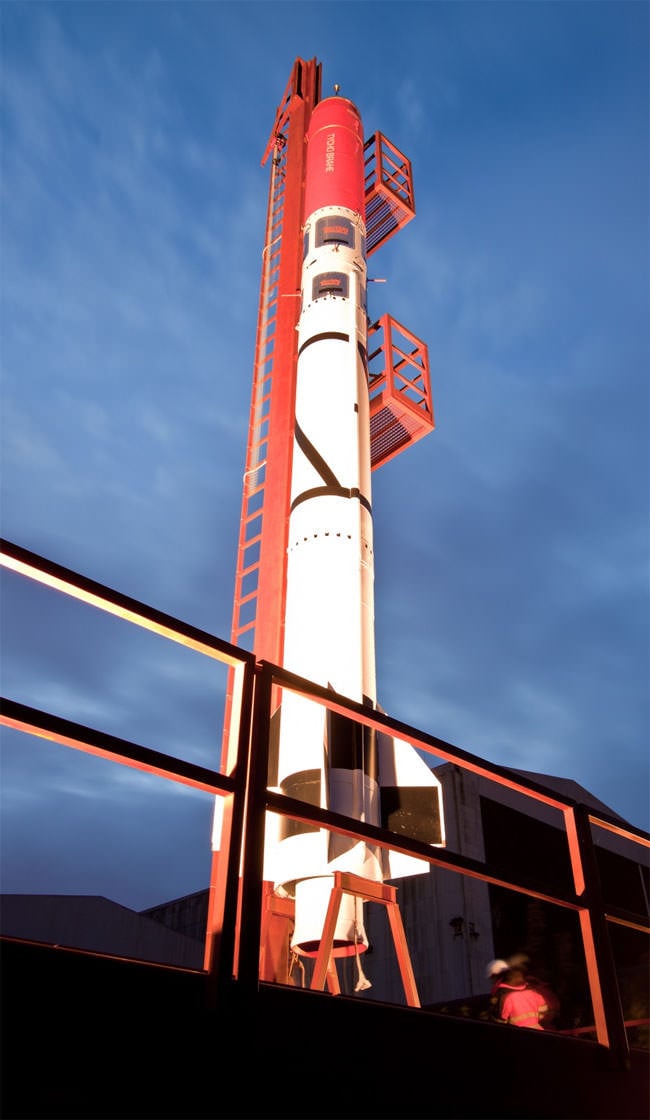[/caption]
It's something like the movie "Astronaut Farmer," but this is for real. And it's in Danish.
Copenhagen Suborbitals,
headed by Kristian von Bengtson and Peter Madsen, hope to launch the world's first amateur-built rocket for human space travel. As of this writing, the launch countdown clock on the Copenhagen Suborbitals' website reads 7 days and 12 hours, which would put the launch on August 30 at about 1300 GMT. This upcoming flight will be an unmanned test flight, but if all goes well, Madsen hopes to be inside the single-passenger capsule named Tycho Brahe for a manned flight in the near future. They have a sea-launch site on the Baltic Sea near Bornholm, Denmark, and their HEAT 1-X rocket is ready to go.
[caption id="attachment_71848" align="aligncenter" width="580" caption="Peter Madsen and Kristian von Bengtson. Credit: Copenhagen Suborbitals."]
[/caption]
The team has been building their hybrid rocket since about 2004. Copenhagen Suborbitals is a non-profit endeavor, based entirely on sponsors and volunteers. Their mission: launch a human being into space. If they are successful, Denmark would become only the fourth nation to send a human into space. But this project is completely private – no national funds have been used. "We are working fulltime to develop a series of suborbital space vehicles - designed to pave the way for manned space flight on a micro size spacecraft," said Madsen and von Bengtson
on their website.
The Hybrid Exo Atmospheric Transporter or HEAT, is their booster rocket. It stands about 9 meters high, and it is a real scale rocket with a 640 mm diameter tube and uses liquid oxygen (LOX) for fuel. The HEAT booster will burn for about 60 seconds, providing 40kN of thrust, resulting in less than 3-g making the trip feasible for humans to endure in an upright position. [caption id="attachment_71849" align="aligncenter" width="580" caption="The flight trajectory for the HEAT rocket. Credit: Copenhagen Suborbitals."]
[/caption]
The booster was successfully test-fired in February and May 2010. Copenhagen Suborbitals has also built three other rockets and successfully tested
and flown
them, including a small unmanned sounding rocket, named Hybrid Atmospheric Test Vehicle or HATV and smaller versions of the HEAT rocket.
"The mission has a 100% peaceful purpose and is not in any way involved in carrying explosive, nuclear, biological and chemical payloads," said Madsen and von Bengtson."We intend to share all our technical information as much as possible, within the laws of EU-export control."
Previously, Madsen built the world's largest home-made submarine, UC3 Nautilus. von Bengtson used to work for NASA. "This is the wildest thing I've made," said Madsen in the
Danish publication B.T.
It is much wilder than the submarine." Madsen added that he was tired of waiting for NASA, so decided to build a rocket himself.
The Tycho Brahe capsule is a single passenger capsule with a full view through a polymer plexiglas-dome so that the person can see and experience the entire ballistic ride. It has a pressurized volume providing support for one upright standing/half-sitting person. It will also have additional pressurized space, around and behind the astronaut, available for several other systems necessary for the flight procedure, and to support additional scientific and commercial project.
[caption id="attachment_71847" align="aligncenter" width="544" caption="Peter Madsen inside the Tycho Brahe capsule. Credit: Copenhagen Suborbitals."]
[/caption]
Copenhagen Suborbitals is taking donations,
so check out their website.
There's also lots of images and videos available, on the site, too.
Since I am of one-half Danish heritage, I find this especially exciting. We'll be following the progress of the Copenhagen Suborbitals' historic flight. Stay tuned!
 Universe Today
Universe Today
